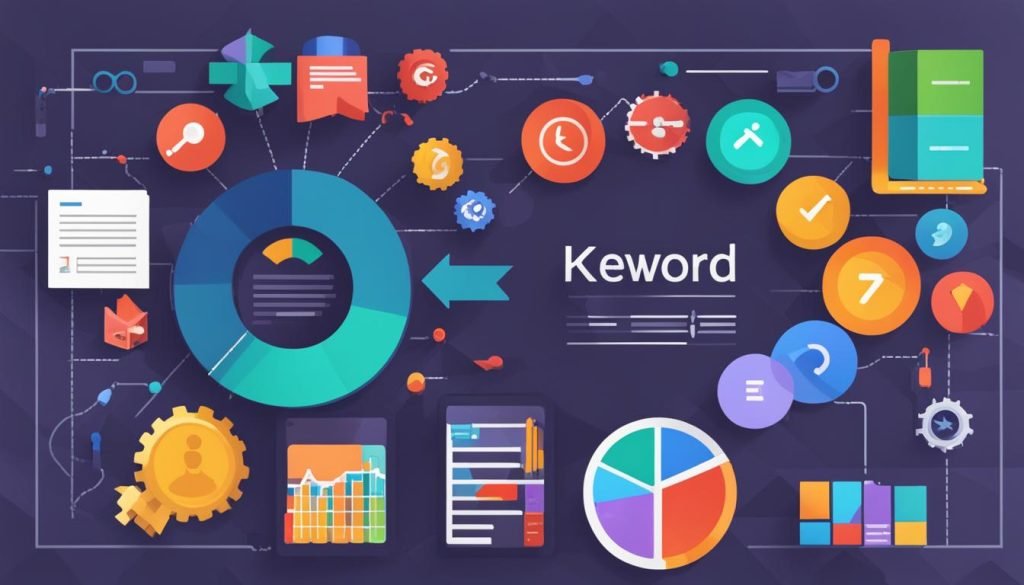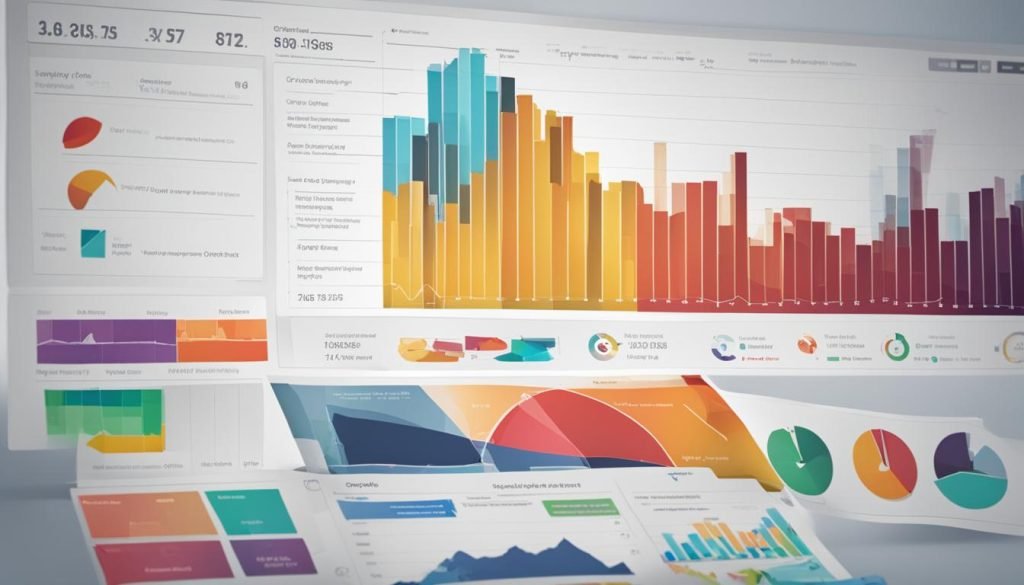As businesses strive to establish a solid online presence, understanding and implementing effective search engine optimization techniques has become crucial. Companies can optimize their websites and content by mastering SEO strategies to increase visibility and attract organic traffic. In this comprehensive guide, I will cover the fundamentals of SEO, including keyword research, on-page and off-page optimization, technical considerations, and tracking progress. With these invaluable SEO tips, businesses can navigate the ever-evolving world of digital marketing and achieve their desired success.
Table of Contents
Understanding Search Engine Optimization
Search engine optimization (SEO) is fundamental for improving website visibility and maximizing online success. By strategically optimizing web pages, businesses can increase their chances of ranking higher on search engine results pages (SERPs) and attract organic traffic. In this section, I will delve into the critical aspects of SEO practice and explain how it can significantly impact website visibility.

SEO is an ongoing process that requires a deep understanding of search engine algorithms and user search behavior. Businesses can enhance their website’s visibility by incorporating relevant keywords, meta tags, and high-quality content. Search engines analyze various factors, including keyword relevancy, website structure, and user engagement metrics, to determine the ranking of web pages.
To optimize website visibility, conducting thorough keyword research and identifying the keywords most relevant to your business and target audience is crucial. By strategically integrating these keywords into your content, meta tags, and URLs, you can increase the likelihood of appearing in relevant search queries.
Moreover, providing valuable and informative content that aligns with the search intent of your target audience is crucial to SEO success. By understanding what users are searching for and delivering content that satisfies their needs, you can enhance user experience and improve your website’s rankings.
The Importance of Keyword Research and Analysis
Keyword research and analysis are crucial components of a successful SEO strategy. By conducting thorough research, businesses can identify the right keywords to target and align their content with the search intent of their target audience. This section will explore the importance of keyword research and how it influences website visibility and organic traffic.
Understanding Search Intent
When performing keyword research, it’s essential to consider the search intent behind each query. Search intent refers to why someone is searching for a specific keyword or phrase. By understanding the meaning, businesses can create content that directly addresses users’ needs and provides relevant information, products, or services.
There are generally four types of search intent:
- Informational: Users are seeking information or answers to questions.
- Navigational: Users are looking for a specific website or resource.
- Transactional: Users intend to make a purchase or complete a particular action.
- Commercial: Users are in the research phase and comparing products or services.
By analyzing search intent, businesses can select targeted keywords that align with their content strategy and optimize their website to attract the right audience.
Targeted Keywords and Long-Tail Keywords
Keyword research helps businesses identify the most relevant and high-performing keywords to target. These keywords are typically divided into two categories: targeted keywords and long-tail keywords.
Targeted keywords are broader terms that have high search volumes. While targeting these keywords can attract a large audience, they often come with higher competition. Businesses should consider their niche, industry, and target audience when selecting targeted keywords.
Long-tail keywords, on the other hand, are more specific and contain multiple words. These keywords usually have lower search volumes but are highly targeted. By focusing on long-tail keywords, businesses can attract a more qualified audience actively searching for specific products or services.
Tools for Keyword Research
Various tools are available to assist in keyword research, providing valuable insights into search volumes, competition levels, and related keywords. Some popular tools include:
- Google AdWords Keyword Planner: Provides keyword ideas, search volumes, and competition levels.
- SEMrush: Offers competitive analysis, keyword research, and tracking features.
- Moz: Provides keyword research, backlink analysis, and SEO performance tracking.
By utilizing these tools, businesses can gather data-driven insights to inform their keyword-targeting strategy and create content that resonates with their target audience.

| Advantages of Keyword Research | Disadvantages of Neglecting Keyword Research |
|---|---|
|
|
On-Page Optimization Techniques
On-page optimization is a crucial aspect of search engine optimization (SEO) that focuses on optimizing individual web pages to improve their visibility and relevance in search engine rankings. It involves various techniques to optimize different elements on a webpage, such as meta tags, content, and URL structure.
Meta Tags
Meta tags are HTML elements that provide information about a webpage to search engines. The two most important meta tags for SEO are the title tag and meta description. The title tag appears as the clickable headline in search engine results, while the meta description briefly summarizes the webpage’s content. Including relevant keywords in these tags can significantly impact the web page’s visibility in search results.
Content Optimization
Content optimization involves creating high-quality and valuable content relevant to the target audience. By incorporating targeted keywords naturally throughout the range, businesses can improve their chances of ranking higher in search engine results. Additionally, organizing the content with headings, subheadings, and bullet points enhances readability and user experience, making it easier for users and search engines to understand its structure and relevance.
URL Structure
The URL structure of a webpage plays a role in optimizing its visibility and accessibility. Creating descriptive and keyword-rich URLs that accurately reflect the webpage’s content is essential. A well-structured URL helps search engines understand the context of the webpage and provides a better user experience by making it easier for users to remember and share the URL.
| On-Page Optimization Techniques | Benefits |
|---|---|
| Meta Tags | Increase visibility in search results |
| Content Optimization | Improve rankings and user engagement |
| URL Structure | Enhance search engine crawling and user experience |
Implementing these on-page optimization techniques can significantly improve a webpage’s visibility, relevance, and user experience. By crafting compelling meta tags, creating valuable content, and optimizing the URL structure, businesses can optimize their web pages for search engines and attract more organic traffic.

Off-Page Optimization Strategies
Off-page optimization is a critical component of successful SEO strategies. By implementing effective off-page techniques, businesses can enhance their online presence, attract relevant traffic, and improve search engine rankings. Two key off-page optimization strategies are building high-quality backlinks and leveraging social media promotion.
Building High-Quality Backlinks
Backlinks are links from other websites that direct users to your website. Search engines view backlinks as a vote of confidence in your website’s credibility and relevance. Building high-quality backlinks from reputable and authoritative websites is crucial for improving your search engine rankings. These backlinks signal to search engines that your website has valuable content and should be considered a reliable source of information.
There are several methods to acquire backlinks:
- Guest blogging: Writing and publishing articles on other websites in your industry. This allows you to include a link to your website in the author bio or within the report.
- Broken link building: Identifying broken links on other websites and contacting web admins to offer your content as a replacement.
- Engaging in industry forums: Actively participate in relevant discussions and include a link to your website in your forum signature or responses to specific questions.
Leveraging Social Media Promotion
Social media platforms provide an excellent opportunity to promote your website and engage with your target audience. By creating and sharing valuable content on social media, businesses can increase brand visibility, drive traffic to their website, and enhance their online reputation.
Here are some effective social media promotion strategies:
- Create engaging and shareable content: Develop content that resonates with your target audience and encourages them to share it on their social media channels.
- Interact with your audience: Respond to social media comments, messages, and mentions to foster a sense of community and build relationships with your followers.
- Collaborate with influencers: Partnering with influencers in your industry can help expand your reach and attract new followers and potential customers.
By implementing these off-page optimization strategies, businesses can strengthen their SEO efforts and improve their online visibility. Building high-qua

Technical SEO Considerations
Regarding search engine optimization (SEO), technical considerations are vital in improving website visibility and performance. By focusing on technical SEO elements, businesses can ensure that their websites are correctly structured, optimized for speed, and easily crawlable by search engines.

A critical aspect of technical SEO is website structure. A well-structured website with straightforward navigation helps search engine crawlers understand the content and hierarchy of the site. By organizing the site into logical categories and implementing breadcrumbs, businesses can improve user experience and make it easier for search engines to index their web pages.
Site speed is another critical factor for both user experience and SEO rankings. Slow-loading web pages frustrate users and negatively impact search engine rankings. To optimize site speed, businesses can compress images, minify CSS and JavaScript files, and enable browser caching. By reducing the file size and improving caching, websites can load faster and provide a better user experience.
| Technical SEO Considerations | Benefits |
|---|---|
| Website structure | Improves user experience and search engine crawling |
| Site speed optimization | Enhances user experience and improves search engine rankings |
| XML sitemaps | Facilitates search engine crawling and indexing |
Implementing XML sitemaps is another essential technical SEO consideration. XML sitemaps provide search engines with a roadmap of all the pages on the website, ensuring that no valuable content goes unnoticed. By submitting the XML sitemaps to search engines, businesses can help search engines crawl and index their web pages more efficiently.
In conclusion, technical SEO considerations are crucial for optimizing website structure, improving site speed, and facilitating search engine crawling. By addressing these technical aspects, businesses can create a solid foundation for their SEO efforts, leading to improved visibility and better user experience.
Mobile Optimization for Better Rankings
As the usage of mobile devices continues to rise, mobile optimization has become an essential aspect of search engine optimization (SEO). Implementing responsive design is crucial to ensure that websites adapt seamlessly to different screen sizes and provide a user-friendly experience across all devices.
Responsive design allows websites to adjust their layout and content based on the device, whether a smartphone, tablet, or desktop computer. This ensures visitors can easily navigate and consume the content without issues, leading to higher engagement and better rankings in mobile search results.
- In addition to responsive design, mobile page speed plays a significant role in mobile optimization. With mobile users expecting fast-loading websites, optimizing image sizes, minimizing CSS and JavaScript files, and enabling AMP (Accelerated Mobile Pages) can significantly improve page load times. By enhancing mobile page speed, websites are more likely to rank higher and provide a better user experience for mobile visitors.
Benefits of Mobile Optimization:
- Improved user experience on mobile devices
- Higher search engine rankings in mobile search results
- Increase in website traffic and engagement from mobile users
- Expanded reach to a broader audience
“Mobile optimization is not a choice but a necessity in today’s digital landscape. With more and more users relying on their mobile devices for accessing information and making purchasing decisions, businesses need to ensure their websites are optimized for mobile. By implementing responsive design and focusing on mobile page speed, businesses can improve their SEO rankings and provide a seamless browsing experience for mobile users.”

| Mobile Optimization Techniques | Benefits |
|---|---|
| Implement responsive design | Adapts to different screen sizes, improves user experience |
| Optimize mobile page speed | Reduces bounce rate, improves search engine rankings |
| Enable AMP (Accelerated Mobile Pages) | Enhances page load times, improves mobile user experience |
Creating Engaging and Relevant Content
Regarding search engine optimization (SEO), content optimization is crucial in improving visibility and attracting organic traffic. By conducting thorough keyword research and integrating targeted keywords naturally into the content, businesses can improve their chances of ranking higher in search engine results. But content optimization goes beyond keyword integration. It involves creating high-quality and engaging content that resonates with the target audience.
One effective way to enhance content engagement is by organizing it with headings, subheadings, and bullet points. This not only improves readability but also helps search engines understand the structure of the content. Additionally, incorporating multimedia elements such as images, videos, and infographics can enhance engagement and improve SEO performance. These elements break up the text, provide visual appeal, and offer alternative ways for users to consume the information.
“Content optimization is not just about stuffing keywords into the text. It’s about creating valuable and engaging content that attracts and captivates the target audience.”
- Moreover, ensuring that the content is relevant and provides value to the readers is essential. By addressing their pain points, answering their questions, and offering practical solutions, businesses can establish themselves as industry experts and build trust with their audience.

Content Optimization Checklist
Here’s a checklist to help you optimize your content for SEO:
- Perform comprehensive keyword research and identify targeted keywords
- Naturally integrate keywords into the content, including the title, headings, and body
- Organize the content with headings, subheadings, and bullet points for improved readability and SEO
- Include relevant multimedia elements such as images, videos, and infographics to enhance engagement
- Address the target audience’s pain points and provide valuable solutions
- Regularly update and refresh the content to keep it relevant and up-to-date
- Promote the content through social media channels and encourage sharing and engagement
By following these content optimization best practices, businesses can create engaging and relevant content that not only attracts organic traffic but also provides value to their audience. Remember, in the world of SEO, content is king!
| Benefits of Content Optimization | Challenges of Content Optimization |
|---|---|
| Increased visibility | Keyword research and integration |
| Higher organic rankings | Creating valuable and engaging content |
| Improved user engagement | Keeping the content relevant and up-to-date |
| Establishing industry authority | Promoting and sharing the content |
Optimizing Website Speed and Performance
Website speed and performance are crucial in search engine optimization (SEO). A slow-loading website can negatively impact user experience, increase bounce rates, and lead to lower search engine rankings. Therefore, it is essential to optimize the speed and performance of your website to ensure a seamless browsing experience for your visitors.
Optimizing page elements such as images is critical to improving website speed. Large image files can significantly slow down your website’s load time. To address this, you can compress images without compromising their quality. Image compression reduces the file size, allowing it to load faster while maintaining visual appeal. Additionally, consider implementing lazy loading, which prioritizes the loading of visible elements and defers the loading of non-visible components until they are needed.
| Image Optimization Techniques | Benefits |
|---|---|
| Image Compression | Reduces file size while maintaining quality |
| Lazy Loading | Prioritizes loading of visible elements |
| Image Format Selection | Optimizes images for different screen sizes |
Another factor that affects website speed is proper page optimization. This involves optimizing HTML, CSS, and JavaScript code to reduce file sizes and improve load times. Minifying these files removes unnecessary spaces, comments, and line breaks, resulting in smaller file sizes. Additionally, consider enabling browser caching, which allows returning visitors to load your site more quickly by storing some aspects on their devices.
HTML Optimization Techniques:
- Minify CSS, JavaScript, and HTML files
- Enable browser caching
- Reduce unnecessary HTTP requests
In summary, optimizing website speed and performance can enhance user experience, reduce bounce rates, and improve search engine rankings.
In summary, optimizing website speed and performance can enhance user experience, reduce bounce rates, and improve search engine rankings. Focus on image optimization, page optimization, and implementing best practices such as lazy loading and browser caching. These strategies will help ensure that your website loads quickly and efficiently, providing a seamless browsing experience for your visitors. Remember, a faster website leads to happier users, higher engagement, and improved SEO performance.

Tracking and Analyzing SEO Efforts
Tracking and analyzing SEO efforts are crucial for businesses to measure the effectiveness of their optimization strategies and make data-driven decisions for further improvements. By utilizing various analytics tools, companies can gain valuable insights into website traffic, user behavior, and conversion rates. This data provides a comprehensive understanding of how SEO efforts perform and enables businesses to refine their strategies accordingly.
One of the most widely used analytics tools is Google Analytics. With its robust features and easy-to-navigate interface, businesses can track the number of visitors to their website, identify traffic sources, and analyze user behavior on different pages. This data helps identify which pages are performing well and which need optimization. Google Analytics also provides valuable demographic information about website visitors, allowing businesses to tailor their content and marketing efforts to target specific audience segments.
In addition to Google Analytics, other analytics tools such as Moz, SEMrush, and Ahrefs offer comprehensive insights into SEO performance. These tools provide detailed reports on keyword rankings, backlink profiles, and competitor analysis, allowing businesses to stay updated on the competitive landscape and make informed decisions. By regularly monitoring these analytics metrics, companies can identify trends, uncover opportunities, and optimize their SEO strategies to achieve better results.
“Analytics tools are essential for tracking the success of your SEO efforts. They help you understand how users interact with your website, which pages are performing well, and where there are opportunities for improvement. By analyzing data from these tools, you can make data-driven decisions and optimize your website to attract more organic traffic.”
Key Metrics to Track with Analytics Tools:
- Website Traffic: Monitor the number of visitors to your website over time to gauge the effectiveness of your SEO efforts.
- Keyword Rankings: Keep track of your targeted keywords and their rankings to measure the visibility of your website on search engine results pages.
- User Behavior: Analyze user engagement metrics such as bounce rate, time on page, and conversion rates to understand how users interact with your website.
- Backlink Profiles: Monitor the quality and quantity of backlinks pointing to your website to assess its authority and credibility.
By regularly tracking and analyzing these metrics, businesses can gain valuable insights into the effectiveness of their SEO strategies and make informed decisions to optimize their website for better performance and increased organic traffic.

| Analytics Tools | Main Features |
|---|---|
| Google Analytics |
|
| Moz |
|
| SEMrush |
|
| Ahrefs |
|
As the field of SEO continues to evolve, businesses must stay abreast of the latest trends to achieve digital marketing success. Key areas to focus on are voice search optimization, local SEO, and enhancing user experience.
Voice search optimization is becoming increasingly important as more and more people use voice assistants like Siri and Alexa to search for information. Businesses can improve their visibility and attract voice search users by optimizing content to match voice search queries and incorporating natural language.
Local SEO is another vital aspect, especially for businesses with physical locations. Optimizing for local searches, such as “near me” queries, can help companies attract local customers and drive foot traffic to their stores. This involves creating local business listings, optimizing Google My Business profiles, and earning positive reviews.
Lastly, optimizing for user experience should always be a priority. From fast page load times to mobile-friendly designs, businesses must ensure that their websites provide users with a seamless and enjoyable experience. This improves search engine rankings and increases user engagement and conversions.
FAQ
What is search engine optimization (SEO)?
Search engine optimization (SEO) is the practice of optimizing web pages to improve their visibility and ranking on search engine results pages (SERPs).
Why is SEO important for businesses?
SEO is essential for businesses to improve their online presence and attract organic traffic. By mastering SEO techniques, businesses can optimize their websites and content to increase visibility and attract potential customers.
What is keyword research and analysis?
Keyword research plays a crucial role in effective SEO. It involves identifying target keywords and understanding the search intent of the target audience. By incorporating these keywords strategically throughout the website’s content and meta tags, businesses can improve their chances of ranking higher in search engine results.
What is on-page optimization?
On-page optimization involves optimizing individual web pages to improve their visibility and relevance. This includes optimizing meta tags, such as the title tag and meta description, and creating high-quality, valuable content that incorporates targeted keywords naturally.
What is off-page optimization?
Off-page optimization refers to activities performed outside of the website to improve its visibility and authority. This includes building high-quality backlinks, social media promotion, guest blogging, and online reputation management.
What is technical SEO?
Technical SEO focuses on the backend aspects of the website that affect its visibility and performance. It includes optimizing website structure, improving site speed, and implementing XML sitemaps.
Why is mobile optimization important for SEO?
Mobile optimization is crucial for SEO success, considering the increasing usage of mobile devices. Implementing responsive design and optimizing mobile page speed can help improve search engine rankings for mobile searches.
How can businesses create engaging and relevant content for SEO?
By conducting keyword research and integrating targeted keywords naturally into the content, businesses can improve visibility and attract the right audience. Organizing content with headings, subheadings, and bullet points enhances readability, and incorporating multimedia elements enhances engagement.
How does website speed and performance affect SEO?
Website speed and performance are vital for SEO rankings and user experience. Optimizing page speed by compressing images, minifying CSS and JavaScript, and enabling browser caching improves load times and user satisfaction.
How can businesses track and analyze their SEO efforts?
Using analytics tools like Google Analytics provides insights into website traffic, user behavior, and conversion rates. This data helps identify areas for improvement, refine SEO strategies, and make data-driven decisions for better results.
What are some emerging SEO trends to watch out for?
Voice search optimization, local SEO, and optimizing for user experience are some of the emerging trends in the field of SEO.
Source Links
- https://medium.com/@copydashai/mastering-the-art-of-search-engine-optimization-seo-a-guide-for-digital-marketers-e8c5948220d8
- https://www.triangledirectmedia.com/blog/mastering-seo-the-ultimate-guide-to-search-engine-optimization-for-your-website.html
- https://www.lookatseo.com/2023/06/mastering-search-engine-optimization.html?m=1











